Abstract
The electron microscopic structure of cilia from the inferior turbinate of the nose was studied in 12 adults, four with chronic sinusitis, one with allergic rhinitis, two with bronchiectasis, three with deviated nasal septum, and two normals. The changes are compared with those found in nasal cilia in 14 patients with retinitis pigmentosa. There were compound cilia in the seven cases with chronic sinusitis, allergic rhinitis, and bronchiectasis but, apart from this, the structure of the cilia was similar in all 12 cases. There were variations in the microtubular pattern in about 4% of cilia, dynein arms were not seen in 4%, and in the rest an average of 5-6 dynein arms were seen in each cilium. The orientation of the cilia was 0 to 90 degrees. In the retinitis pigmentosa patients there was a highly significant increase in cilial abnormalities. The establishment on a quantitative basis of the variations in normal structure of nasal cilila facilitated the recognition of an association between cilial abnormalities and retinitis pigmentosa and should help in the identification of associations that may exist between cilial abnormalities and other diseases.
Full text
PDF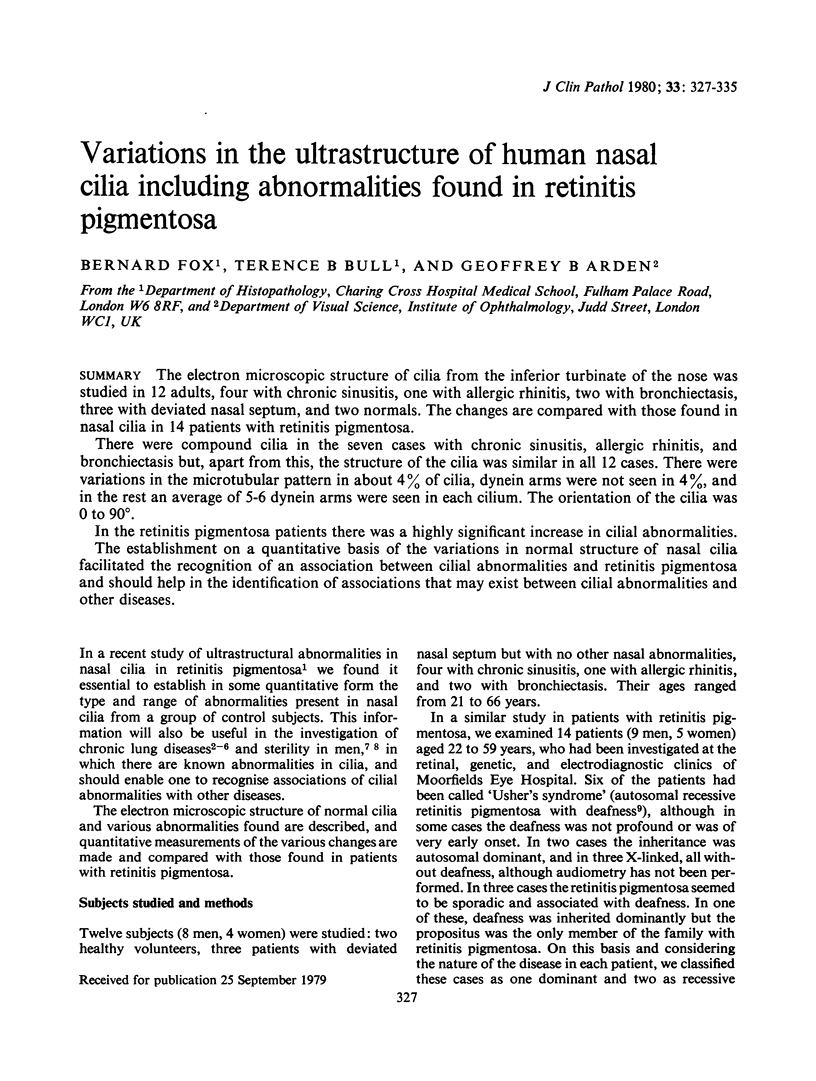
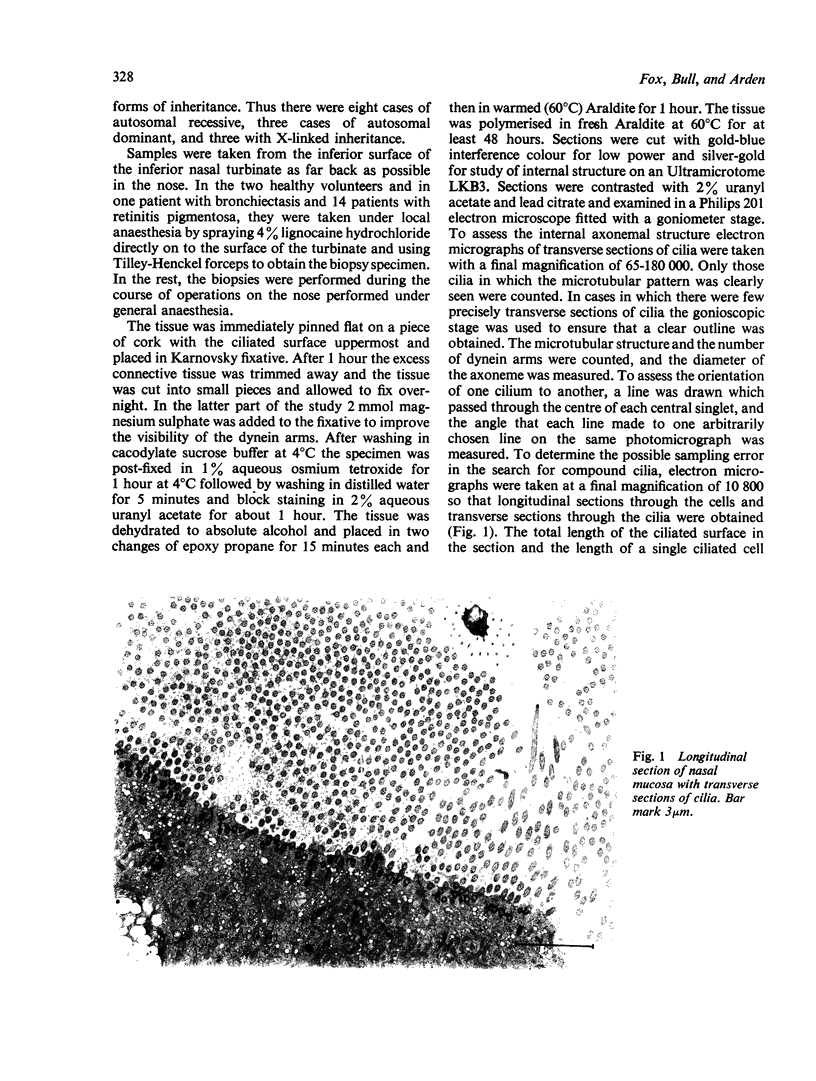


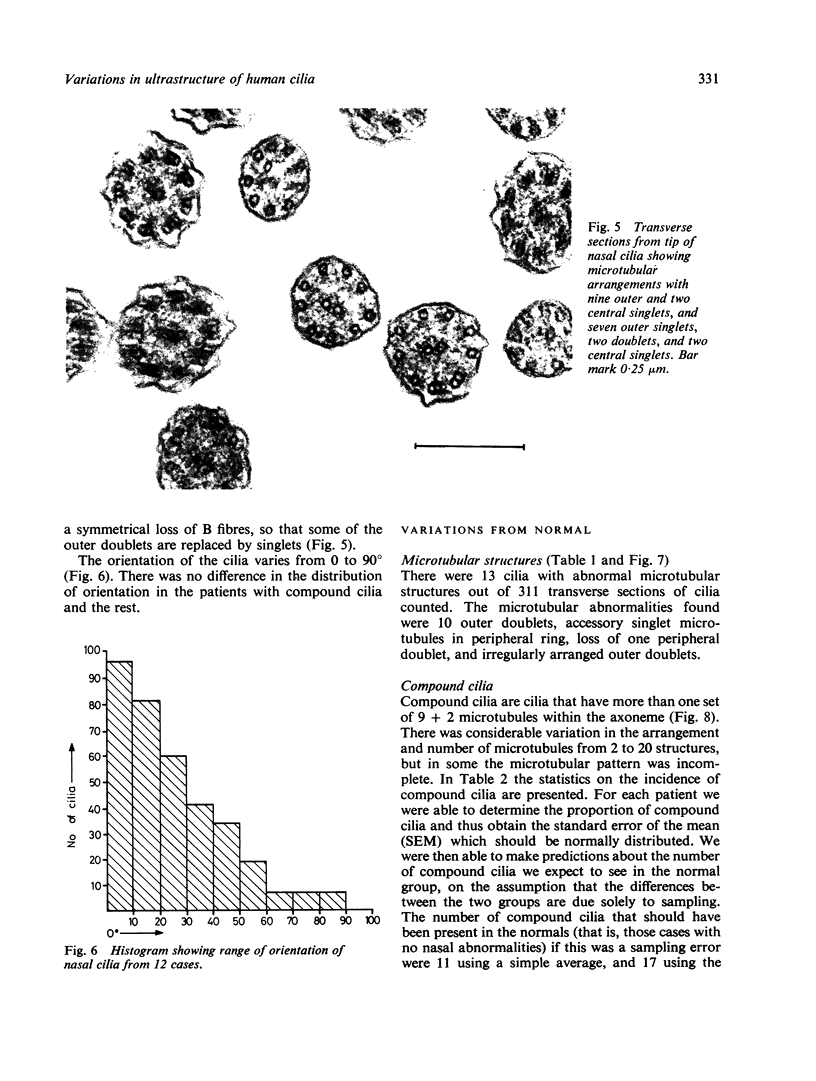

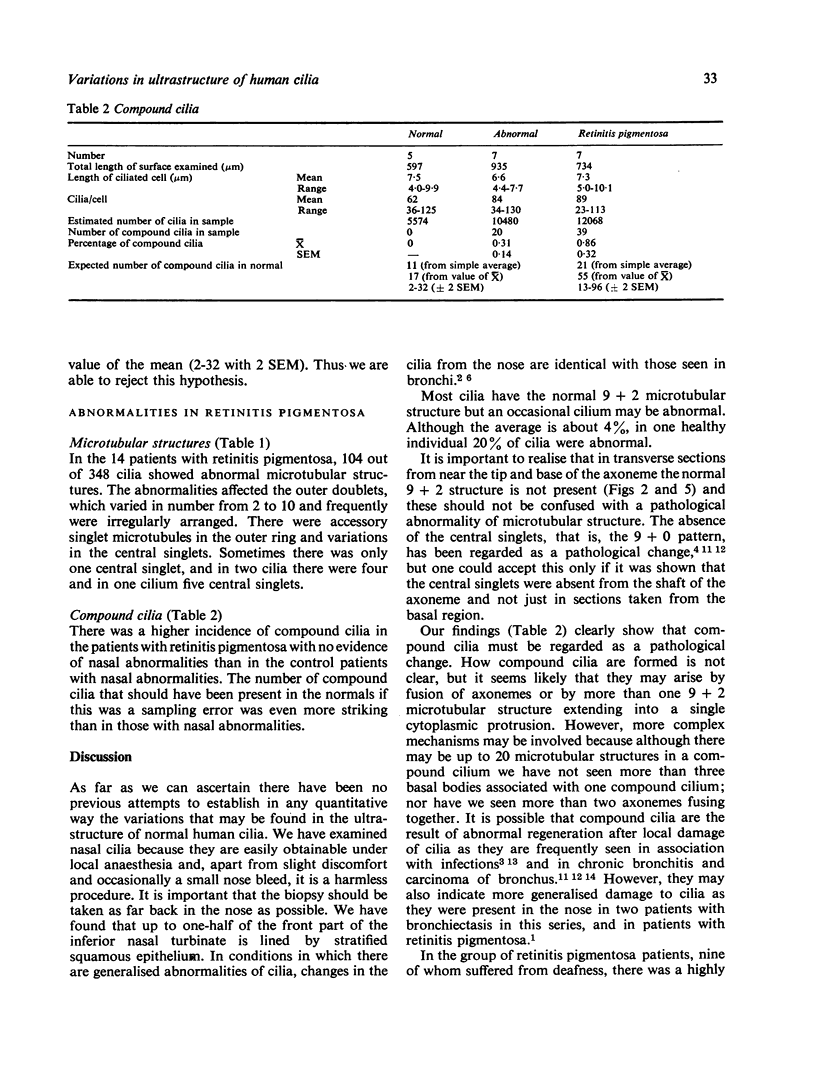

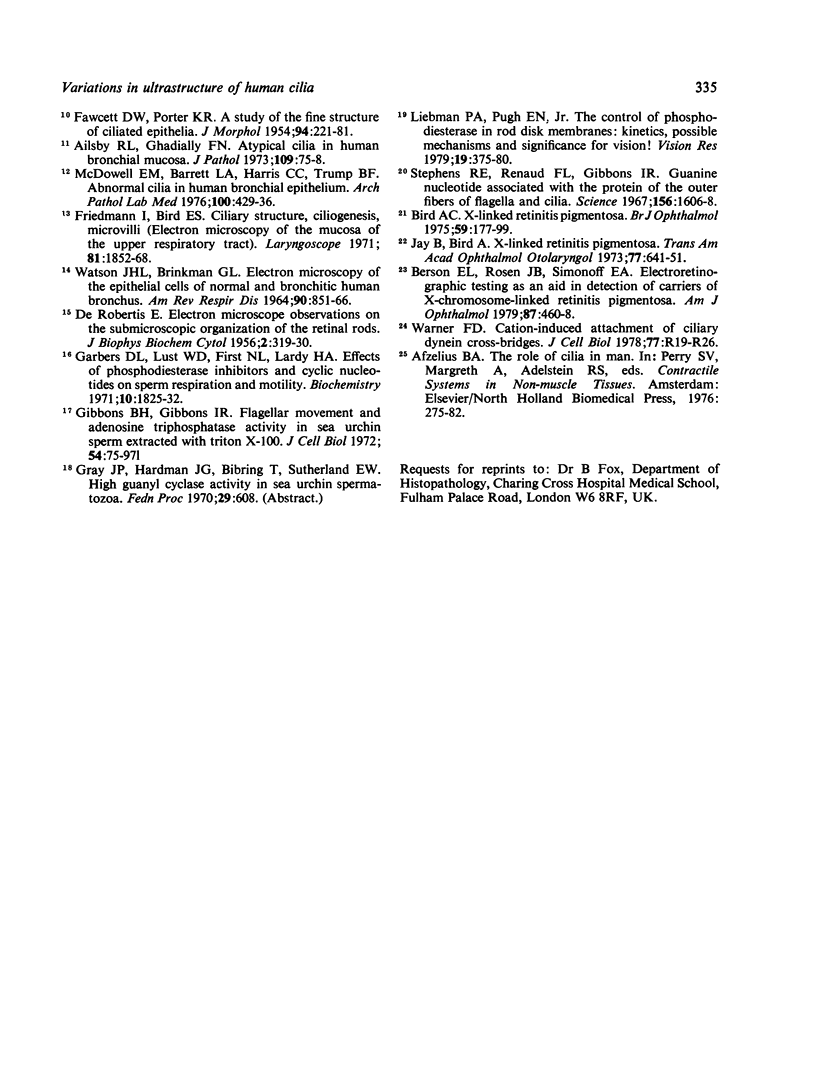
Images in this article
Selected References
These references are in PubMed. This may not be the complete list of references from this article.
- Afzelius B. A., Eliasson R., Johnsen O., Lindholmer C. Lack of dynein arms in immotile human spermatozoa. J Cell Biol. 1975 Aug;66(2):225–232. doi: 10.1083/jcb.66.2.225. [DOI] [PMC free article] [PubMed] [Google Scholar]
- Ailsby R. L., Ghadially F. N. Atypical cilia in human bronchial mucosa. J Pathol. 1973 Jan;109(1):75–78. doi: 10.1002/path.1711090108. [DOI] [PubMed] [Google Scholar]
- Arden G. B., Fox B. Increased incidence of abnormal nasal cilia in patients with retinitis pigmentosa. Nature. 1979 Jun 7;279(5713):534–536. doi: 10.1038/279534a0. [DOI] [PubMed] [Google Scholar]
- Berson E. L., Rosen J. B., Simonoff E. A. Electroretinographic testing as an aid in detection of carriers of X-chromosome-linked retinitis pigmentosa. Am J Ophthalmol. 1979 Apr;87(4):460–468. doi: 10.1016/0002-9394(79)90231-9. [DOI] [PubMed] [Google Scholar]
- Bird A. C. X-linked retinitis pigmentosa. Br J Ophthalmol. 1975 Apr;59(4):177–199. doi: 10.1136/bjo.59.4.177. [DOI] [PMC free article] [PubMed] [Google Scholar]
- Charles T. J., Johnson N. Cilial abnormality in bronchiectasis. Lancet. 1978 Aug 12;2(8085):382–382. doi: 10.1016/s0140-6736(78)92988-4. [DOI] [PubMed] [Google Scholar]
- DE ROBERTIS E. Electron microscope observations on the submicroscopic organization of the retinal rods. J Biophys Biochem Cytol. 1956 May 25;2(3):319–330. doi: 10.1083/jcb.2.3.319. [DOI] [PMC free article] [PubMed] [Google Scholar]
- Eliasson R., Mossberg B., Camner P., Afzelius B. A. The immotile-cilia syndrome. A congenital ciliary abnormality as an etiologic factor in chronic airway infections and male sterility. N Engl J Med. 1977 Jul 7;297(1):1–6. doi: 10.1056/NEJM197707072970101. [DOI] [PubMed] [Google Scholar]
- Friedmann I., Bird E. S. Ciliary structure, ciliogenesis, microvilli. (Electron microscopy of the mucosa of the upper respiratory tract). Laryngoscope. 1971 Nov;81(11):1852–1868. doi: 10.1288/00005537-197111000-00010. [DOI] [PubMed] [Google Scholar]
- Gibbons B. H., Gibbons I. R. Flagellar movement and adenosine triphosphatase activity in sea urchin sperm extracted with triton X-100. J Cell Biol. 1972 Jul;54(1):75–97. doi: 10.1083/jcb.54.1.75. [DOI] [PMC free article] [PubMed] [Google Scholar]
- Liebman P. A., Pugh E. N., Jr The control of phosphodiesterase in rod disk membranes: kinetics, possible mechanisms and significance for vision. Vision Res. 1979;19(4):375–380. doi: 10.1016/0042-6989(79)90097-x. [DOI] [PubMed] [Google Scholar]
- Lupin A. J., Misko G. J. Kartagener syndrome with abnormalities of cilia. J Otolaryngol. 1978 Apr;7(2):95–102. [PubMed] [Google Scholar]
- McDowell E. M., Barrett L. A., Harris C. C., Trump B. F. Abnormal cilia in human bronchial epithelium. Arch Pathol Lab Med. 1976 Aug;100(8):429–436. [PubMed] [Google Scholar]
- Pedersen H., Rebbe H. Absence of arms in the axoneme of immobile human spermatozoa. Biol Reprod. 1975 Jun;12(5):541–544. doi: 10.1095/biolreprod12.5.541. [DOI] [PubMed] [Google Scholar]
- Stephens R. E., Renaud F. L., Gibbons I. R., Stevens R. E. Guanine nucleotide associated with the protein of the outer fibers of flagella and cilia. Science. 1967 Jun 23;156(3782):1606–1608. doi: 10.1126/science.156.3782.1606. [DOI] [PubMed] [Google Scholar]
- Sturgess J. M., Chao J., Wong J., Aspin N., Turner J. A. Cilia with defective radial spokes: a cause of human respiratory disease. N Engl J Med. 1979 Jan 11;300(2):53–56. doi: 10.1056/NEJM197901113000201. [DOI] [PubMed] [Google Scholar]
- WATSON J. H., BRINKMAN G. L. ELECTRON MICROSCOPY OF THE EPITHELIAL CELLS OF NORMAL AND BRONCHITIC HUMAN BRONCHUS. Am Rev Respir Dis. 1964 Dec;90:851–866. doi: 10.1164/arrd.1964.90.6.851. [DOI] [PubMed] [Google Scholar]
- Waite D., Wakefield J. S., Steele R., Mackay J., Ross I., Wallace J. Cilia and sperm tail abnormalities in Polynesian bronchiectatics. Lancet. 1978 Jul 15;2(8081):132–133. doi: 10.1016/s0140-6736(78)91511-8. [DOI] [PubMed] [Google Scholar]
- Warner F. D. Cation-induced attachment of ciliary dynein cross-bridges. J Cell Biol. 1978 Jun;77(3):R19–R26. doi: 10.1083/jcb.77.3.r19. [DOI] [PMC free article] [PubMed] [Google Scholar]









